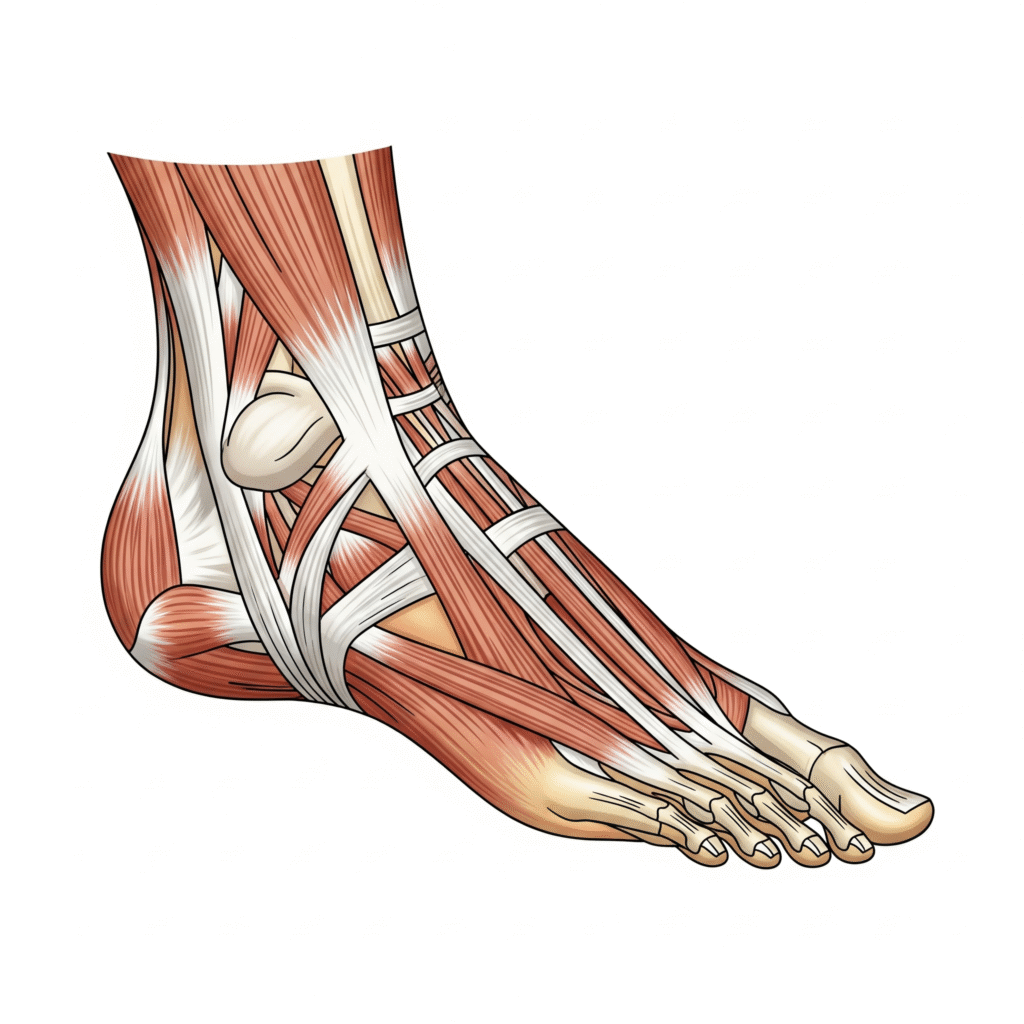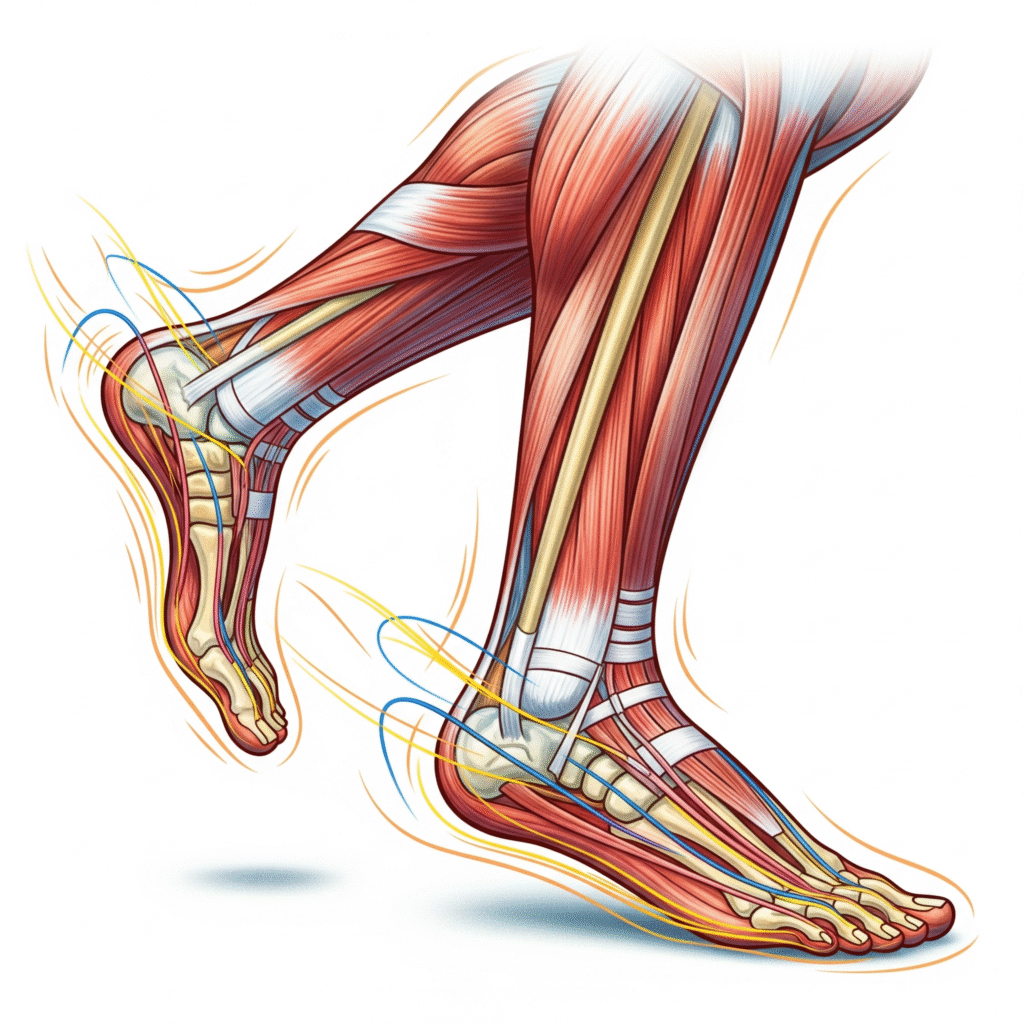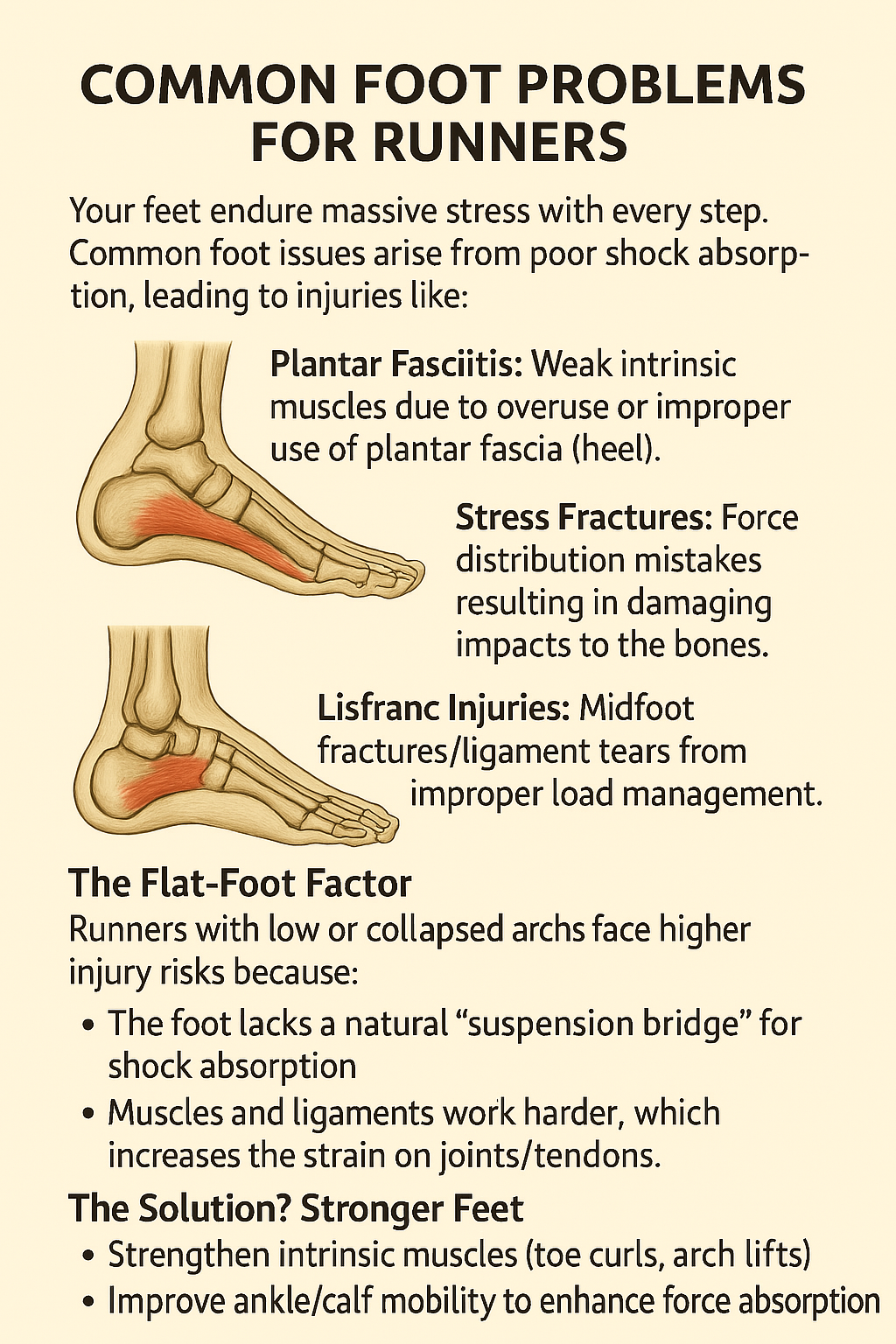- Your Feet: The Unsung Heroes of Injury Prevention in Running
- Basic Structure of the Foot Muscles
- Why Is Your Foot Strength So Vital for Running?
- How Does Your Foot Work While Running?
- What Could Go Wrong?
- Why Foot Strength Matters
- Common Foot Problems for Runners
- The Ultimate Guide to Foot Strength for Runners
- 6 Essential Foot Strength Exercises
- Common Foot Problems & How Foot Strength Workouts Help
- How to Incorporate Foot Strength Work into Your Routine
- Exercises for Ankle Joints for Foot Strength
- Final thoughts on foot strength
Running cannot be your only workout activity because you will gradually lose your impact resistance ability and increase the risk of injuries and muscle strain. Many runners are just counting miles and do not give due importance to muscle training, joint mobility, and injury care. When it comes to building leg strength, we think mostly about power-generating muscles like quads, calves, and glutes, but we miss out on one important component. In this blog, I will talk about foot strength for runners, the often overlooked yet critical component of running that is responsible for weight transfer, forward drive, body balance, shock absorption, and injury prevention.
Your Feet: The Unsung Heroes of Injury Prevention in Running
Feet-focused exercises, stretches, and therapies enhance the functioning of joints and your stride efficiency. Your running performance and body balance will improve remarkably if you develop strong feet. That, in turn, will make you capable of handling higher mileage while reducing the chances of injuries. Your feet will strike the ground on each step, so working on foot strength is not optional for runners. It is the foundation of sustaining and extending your passion for running for many years to come.
Basic Structure of the Foot Muscles
Our feet may be small when compared to the rest of our body, but it is pretty complex – With 26 bones, 30 joints, and over 100 muscles, tendons, and ligaments, the foot functions as a critical system for running, walking, bending, jumping, and landing. There are intrinsic muscles within the foot and also extrinsic ankle muscles that extend outward from the ankle structure.
The intrinsic muscles, particularly the hallucis brevis (big toe control) and digitorum brevis (smaller toe control), are essential tools for runners. The foot muscles strengthen joint stability during movements, while their flexors and extensors directly affect the transition from ground contact to push-off.

The quadratus plantae (2nd Layer muscle) strengthens toe flexion, which helps with both shock absorption and propulsion functions. Weak quadratus causes improper foot movements that extend the kinetic chain effect to knees and hips. You can strengthen your foot with drills like toe curls, marble pickups with toes, and barefoot runs. These drills will help to maintain stability and reduce injury chances while boosting your running efficiency.
Why Is Your Foot Strength So Vital for Running?
Your strides are powered by 28 bones and 33 joints, and with over 100 tendons/ligaments from the knee down. However, there are a few weak links in the complex foot anatomy that can get injured due to overload or intensity and lead to the weakening of your strides. For example – Your body gets the propulsion through calf muscle activity, which utilizes the Achilles tendon to generate power from the feet. The primary point of foot weakness in runners is the Achilles tendon.
Every stride begins with the foot strike, which dictates your entire gait cycle. Proper alignment, landing force, and ankle stability determine shock absorption and efficiency. Intrinsic muscles within the arch facilitate proper energy transfer in the feet throughout the running movement cycles. Poor foot biomechanics, running form, and weak muscles cause excessive strain on joints and lead to injuries.
You can improve your strength and resilience with ankle-foot exercises like toe curls and calf raises, along with balance training. Balance training is a key aspect often overlooked in foot strengthening. It helps in developing proprioception, which is the body’s ability to sense its position in space. This, in turn, enhances your running performance while reducing injury risks and enhancing your running economy.
How Does Your Foot Work While Running?
The foot requires two essential capabilities during running – First, to absorb the impact forces and then to maintain stability with one leg at a time. Dual functionality depends on how muscles act actively and how non-contractile structures work passively.
Your mobile intrinsic and extrinsic foot muscles work with passive tissue structures to stabilize your arch and disperse the pressure loads throughout the foot.They collaborate to act as a suspension bridge system that assists your arch during flattening under load and rebounding for forward propulsion. Elastic rebound from the medial longitudinal arch recoil helps achieve efficient energy transfer.

What Could Go Wrong?
The deterioration of any structure in your foot will force the neighbouring stabilizers to develop improper compensatory actions. Some of the failures of these biomechanics may not cause too much pain, and you may continue to repeat the mistakes in your running form for an extended period. This interdependence is called the ‘concept of redundancy’ in foot biomechanics. It means that the foot has multiple structures that can perform the same function, but if one structure fails, the others must compensate, leading to potential issues like plantar fasciitis and Achilles strain.
Why Foot Strength Matters
All structures and units will work harmoniously in your feet if you strengthen your foot core muscles (e.g., toe curls, arch lifts) and improve mobility (ankle/calf drills). It will effectively work towards reducing strain and enhancing performance. A resilient foot is not just about strength – It is also about balance and coordinated load transfer from landing to push-off.
Common Foot Problems for Runners
Your feet endure massive stress with every step. Common foot issues arise from poor shock absorption, leading to injuries like:
- Plantar Fasciitis: Weak intrinsic muscles due to overuse or improper use of plantar fascia (heel).
- Stress Fractures: Force distribution mistakes resulting in damaging impacts to the bones.
- Lisfranc Injuries: Midfoot fractures/ligament tears from improper load management.
The Flat-Foot Factor
Runners with low or collapsed arches face higher injury risks because:
- The foot lacks a natural “suspension bridge” for shock absorption.
- Muscles and ligaments work harder, which increases the strain on joints/tendons.
The Solution? Stronger Feet
- Strengthen intrinsic muscles (toe curls, arch lifts).
- Improve ankle/calf mobility to enhance force absorption.
- Wear supportive footwear if you have flat feet.
Pro Tip: Don’t ignore any pain in your foot. Early intervention prevents chronic issues!

The Ultimate Guide to Foot Strength for Runners
Why Foot Strength Matters?
- Your feet endure 2-3x body weight with every step.
- Weak foot muscles lead to poor shock absorption, increasing injury risk.
- Strong intrinsic muscles enhance both stability and performance together with improved efficiency.
- When we neglect foot strength, the movement chain of the force deteriorates, harming knee joints, hip joints, and the back.
6 Essential Foot Strength Exercises
1. Short(en) Foot (For Arch Activation)
- Goal: Lift the arch without curling toes.
- How to do it: Sit on a chair barefoot, press your toes lightly into the ground, and shorten the length of the foot by drawing the ball of the foot toward the heel.
- Key cue: Imagine a string pulling your first metatarsal backwards.
Why it works: Strengthens the posterior tibialis and intrinsic arch muscles.
2. Towel Scrunches (For Toe Flexor Strength)
- Goal: Improve toe flexion and arch control.
- How to do it: Place a towel on the floor and use your toes to scrunch it up, keeping your heel grounded. Lift and extend your toes before curling them forward to grip the towel. Focus on deepening your arch and engaging intrinsic foot muscles. Begin seated, then progress to standing as strength and control improve.
- Focus: Keep the heel planted and arch engaged.
Why it works: Targets flexor digitorum brevis and plantar fascia.
3. Toe Yoga (For Neuromuscular Control)
- Goal: Isolate toe movements for better muscle recruitment.
- How to do it: Lift only the big toe while keeping others down (or vice versa).
- Challenge: Alternate toe lifts slowly.
Why it works: Enhances intrinsic muscle coordination.
4. Marbles Pickups (For Dynamic Strength)
- Goal: Develop precision and grip strength.
- How to do it: Drop small objects into a cup by only using your toes.
- Progression: Try smaller objects like dice or marbles.
Why it works: Engages toe flexors and arch stabilizers.
5. Ankle & Foot Stability Drills
- Goal: Improve balance and proprioception.
- How to do it: Step barefoot onto a soft surface like a foam pad using one foot.
- Advanced: You can make it tougher by closing your eyes or doing small knee bends.
Why it works: Strengthens extrinsic foot-ankle muscles.
6. Calf & Ankle Mobility
- Goal: Prevent stiffness for better shock absorption.
- How to do it: Calf stretches (wall leans) + ankle circles.
- Bonus: Use a foam roller on calves.
Why it works: Tight calves restrict arch recoil and cut down the power of your strides.
7. Big Toe Press
- Goal: The big toe plays a crucial role in generating power and maintaining foot stability. Without its strength, that power leaks and affects overall joint functions.
- How to do it: To train it, stand tall with feet flat. Push your big toe downward into the ground as all other toes stay relaxed until your arch rises. Perform this exercise for 10 seconds ten times over each foot.
- Pro Tip: Mastering this exercise requires multiple attempts, so stick to it until you achieve success.
Why it works: The big toe plays a crucial role in generating power and maintaining foot stability.
Common Foot Problems & How Foot Strength Workouts Help
Plantar Fasciitis
- Cause: Weak foot muscles overload the plantar fascia.
- Fix: Short foot + towel scrunches to reduce strain.
Stress Fractures
- Cause: Poor force distribution by the foot, resulting in excess impact on the bones.
- Fix: Foot drills improve shock absorption.
Flat Feet (Overpronation)
- Cause: Collapsed arches disrupt the suspension bridge effect.
- Fix: Arch-strengthening exercises + stability work.
How to Incorporate Foot Strength Work into Your Routine
- Frequency: 3-5x/week (5-10 mins/day).
- Best time: Post-run or during warm-ups.
- Progression: From sitting to standing to increase the load and intensity.
Bonus: Walk barefoot on grass/sand for natural strengthening.
Let us discuss a few more foot exercises to improve your running. While runners focus on the glutes and quads, the foot, which is our first and last ground contact, is often neglected.
Yet it must:
- Absorb 2-3x body weight with each step
- Power propulsion through the gait cycle
- Move fluidly in all 3 planes of motion
With 25% of the body’s bones and 30+ joints, foot strength is non-negotiable for efficient, injury-free running. Weak feet disrupt the entire kinetic chain. Strengthen them like you would any other muscle because your performance and long-term sustenance depend on it.
Exercises for Ankle Joints for Foot Strength
The ankle is a central junction that integrates all major muscle groups for foot and lower limb activity. You need good ankle strength for proper adaptation to changing ground conditions. Strong ankles provide body stability that extends from the ankles to the hips. Limitation of ankle movements causes imbalance and results in weakened muscles, making you prone to subsequent overuse injuries and strains.
1. Dynamic Ankle Dorsiflexion
Runners usually experience limited dorsiflexion motion, which is the ability to pull the feet upwards. This limitation forces their bodies to compensate across the entire movement chain. The calf muscles will feel tremendous stress during uphill running because of the increased ankle dorsiflexion requirement.
Stand in front of a chair and place one foot on it to reach the knee-to-hip height position, then stretch while using your hands as a knee support. Slowly lean forward while resting your hands on your knee and let your knee glide forward past your toes to attain a stretching position. Do the stretch for some time before slowly extending it deeper between each repetition. To advance the stretch, use your hands to carefully move the knee over the ankle in various mobility positions on the sides.
2. Single Leg Balance
Single-leg balance boosts ankle proprioception, which is vital for athletic performance and injury prevention. Running is essentially repeated single-leg hops, so train one leg at a time. Stand on one leg, raise the other to hip height, hold for 60 seconds, and repeat 3 times. Progress to soft surfaces, then eyes closed for added challenge and stability gains.
3. Lower Leg Exercises
The lower leg powers the foot, with its muscles controlling the movements and absorbing 2–3 times your body weight per step. Weakness in the lower legs leads to tight calves and plantar fasciitis in many endurance runners. Tibialis stretches and calf strengthening exercises will help you have strong lower legs.
4. Penguin Walk
Say goodbye to shin splints with this simple move. Your anterior shin muscles control foot lift and strike, preventing tripping and heavy landings. To train them, walk on your heels with your toes raised high for about 1 minute, or 10 steps forward and 10 steps backward. Repeat 3 times with 30-second rests.
5. Jump Rope
Jump roping boosts foot strength, ankle mobility, and reaction time. Do 3 rounds of 1 minute. It improves impact absorption and balance and makes a perfect warm-up!
6. Weighted Calf Raises for foot strength
This powerhouse exercise targets the soleus and gastrocnemius, boosting endurance and preventing Achilles issues. You can do it by strapping weights, raising your body using the toes, pausing, and then slowly lowering. Focus on balance and control, not speed. Work up to 5 minutes nonstop, starting with 1-minute sets. It realigns the fibers, breaks soft tissue adhesions, and strengthens your lower limbs like nothing else.
Final thoughts on foot strength
Focused physical exercises enhance your foot health by developing lower limb muscles. These workouts will become more effective and safer if you add them to your routines, thus allowing you to progress toward your goals consistently. Runners should not ignore their foot health as it is the point of contact with the ground on each step.